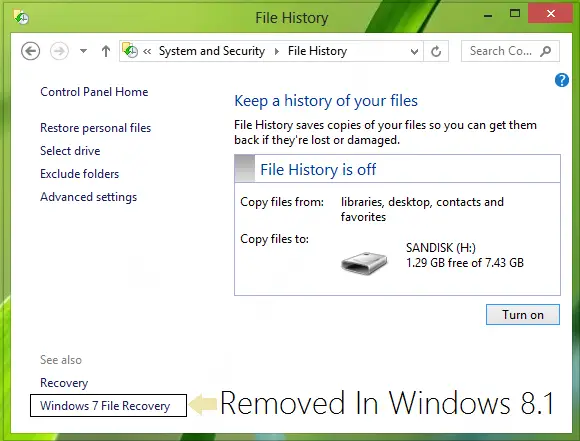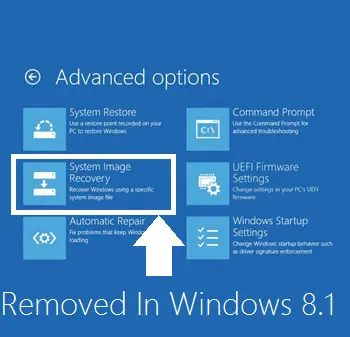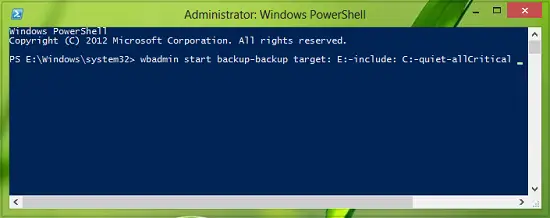If you’re using Windows 11/10 or Windows 8.1, you might have noticed that Windows 7 File Recovery, which was under the hood of File History available in Windows 8 has been removed in Windows 8.1. Due to this, you can’t create backup system images in Windows 8.1, like you could do in Windows 7 or in Windows 8 – but the good thing is that you can still extract the backup images created with Windows 8 or Windows 7.

Create System Image using PowerShell in Windows 11/10
Why did Microsoft Remove the System Image feature?
The reason behind the removal of Windows 7 File Recovery, which we could have used for complete backup or creation of a system image is that Microsoft felt that Windows 7’s backup tools were considered deprecated. That’s why with Windows 8.1, these deprecated tools are no longer present. Another strong reason could be that Microsoft wants to let users completely rely on File History feature – a simple backup solution introduced in Windows 8. Moreover, from the Advanced startup options menu, the “System Image Recovery” option has been removed as well.

So if you’re still looking to create a full system image in Windows 11/10, then you will surely need to use third-party imaging software.
Meanwhile, there is still a way using which you can create a full backup of your Windows 11/10 – the same as you do while using Windows 7 File Recovery in Windows 7 or Windows 8. You will need to use PowerShell for this.
Read: How to validate Windows System Backup Image
Create System Image using PowerShell
1. Open the Windows PowerShell as administrator. To create a System Image in Windows 11/10/8.1 using PowerShell, you will have to run the Wbadmin command.
2. Copy the following command, right click inside the Powershell window and paste it, then press Enter:
wbadmin start backup-backup target: E:-include: C:-quiet-allCritical

Here E: is the target drive where you’re going to save the system image, and C: is the system root drive where Windows is currently installed. Change these variables according to your conditions.
3. To extract the created system image, starting over from Windows USB installation media, select advanced startup or open run and copy:
C: \ Windows \ System32 \ Shutdown.exe / r / o
In this way, you can avoid third-party tools in creating system images by using this procedure instead.
Hope you find the article helpful!
Read:
- How to restore or create System Image in Windows.
- How to create multiple System Images on a single external USB drive.
How do you Create a system image?
Open Control Panel, go to Backup and Restore (Windows 7), and click Create a System Image. Select a location to save the backup, choose the drives to include, and start the backup process.
Does creating a system image wipe the drive?
Creating a system image does not wipe the drive. It instead makes an exact copy of your system’s current state, including the operating system, settings, and files, allowing for easy restoration if needed.
Correct syntax (spacing very important)
wbadmin start backup -backuptarget:E: -include:C: -quiet -allCritical
My Windows 8.1, in Control PanelSystem and SecurityFile History, does have the “System Image Backup” option built in.
^^ I couldn’t find that option :( May I know, which Windows 8.1 edition you’re using?
can i move image file created this way to my external hdd?
thanks
Hi, wbadmin is not Powershell commandlet, so you can run it from classic command prompt (cmd). PS is not necessary.
Maybe a rewrite would be in order, as other pointed out.
“System image backup” is there in: “control panel”->”file history”-> bottom left “System image backup”
“wbadmin” can be run from command prompt
Its definitely in the PRO edition. Looks like its been removed from Home editions.
I don’t remember in Windows 8, but Windows 10 has it, it called Backup and Restore (Windows 7), maybe it called the same in Windows 8.